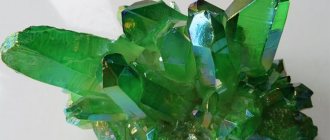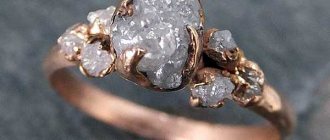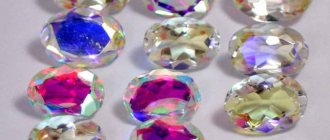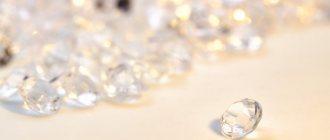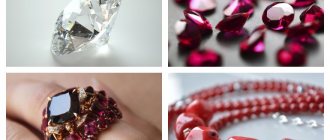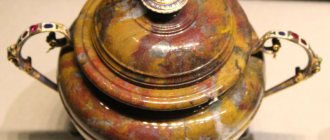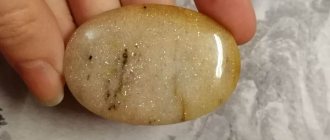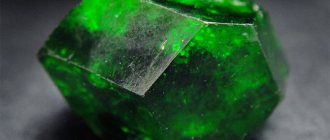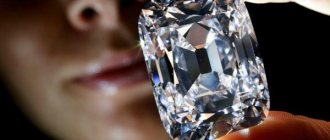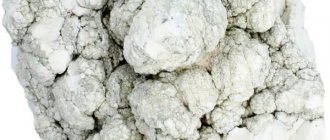Description of green diamond
Natural green diamonds are a rare find. Not every jeweler, even one working in an international gemological laboratory, will see, much less hold, such a stone in his or her lifetime. They rank second in rarity after red diamonds.
In terms of physical and chemical characteristics, green diamonds are not much different from classic colorless diamonds. The main element in their composition is pure carbon. They have a cubic crystal lattice where the atoms are arranged very tightly. This gives such minerals increased hardness.
Green diamonds have the following properties:
- Unsurpassed hardness – 10/10 on the Mohs scale.
- The shine is diamond.
- Color – from a barely noticeable “greenish” to thick, saturated.
- Density – 3.55 g/cm3 (at equal volumes, 3.5 times heavier than water).
- Cleavage is perfect.
- Gives a conchoidal splinter fracture.
- Transparency – translucent, sometimes due to the thickness of the shade it becomes translucent.
- Fragile. Shatters when dropped or hit.
WE BUY A GREEN BEAUTIFUL BABY WISELY
Before buying expensive gems, it is important to make sure they are natural.
How to spot a fake
- Buyers of large natural green diamonds should not worry about authenticity: gems can only be purchased at the largest auctions (Christie's, Sotheby's).
- Auction organizers carefully check the gems before they go up for auction.
- Every green diamond must have a GIA certificate of quality. It is issued by the Gemological Institute of America after careful examination of the sample. The certificate contains complete information: place of extraction, weight, color saturation, etc.
We recommend: HYACINTH - a mineral of Apollo with a thousand-year history
Favorable time to buy
Magicians and astrologers believe that diamonds should only be brought into the house on certain lunar days:
- It is recommended to measure green diamonds for the first time at the end of the lunar month (on the 28th-29th day).
- But it’s better to bring it into the house on the 15th day of the lunar cycle.
Causes of green color
Scientists continue to puzzle over how diamonds of different shades of green were formed in nature. The following factors are believed to have contributed to this:
- The influence of natural radiation. Green nuggets are often found in places where background radiation is high (near uranium deposits). The formation of such stones takes millions of years.
- The action of high temperatures and pressure, which led to a change in the crystal lattice of the mineral.
- Chromium inclusions entering the crystal. This happened at the stage of gem formation.
In order for a transparent diamond to acquire the shade of fresh grass, the following conditions are necessary:
- A certain amount of nitrogen in the composition. This component is found in all diamonds, but its content is not the same in samples of different colors. Green diamonds, in terms of the presence of this substance, occupy an intermediate position between yellow and black diamonds.
- Irradiation with thorium (uranium). If a stone is exposed to alpha particles, it acquires a superficial greenish tint, which disappears during the cutting process. Deep exposure to beta or gamma rays ensures lasting, uniform pigmentation and turns the mineral into an elite green diamond.
WE CARE BEAUTIFULLY
Green diamonds are capricious luxury stones. In order to preserve their presentation longer, certain rules are followed.
What and how to wear it with
Expensive gems in fancy shades are not worn every day. Green diamonds “come out” with the richest people on the globe. The wardrobe must be appropriate: only from the most prestigious fashion houses.
Compatibility with other stones
- Light green gemstones harmonize with colorless diamonds.
- Of the precious metals, only high-grade white gold and platinum are suitable.
- If we take into account the energy combination, green diamonds are not suitable for greenish opaque stones: jade, malachite, amazonite, etc.
Storage and care rules
The storage conditions themselves are not so important as safety. If you are careless about organizing security, the stones can be stolen.
- Each gem should be in a separate box or bag.
- The storage location should be located away from heating devices and sources of increased background radiation.
- You cannot clean gems yourself. No wiping with napkins, washing, etc. Expensive stones are cleaned with ultrasound in jewelry stores.
Related publications
- BLUE DREAM | Luxurious topazes London blue, Swiss blue, Sky blue
- The color of innocence | WHITE SAPPHIRE
- Solomon's Stone | CORUND SAPPHIRE
- WHERE ARE EMERALDS MINED?
Artificial creation of color samples
High-quality green diamonds are so rare that they are known by comparison. Only one such stone is found per year and after cutting (which takes 6-8 months, or even 12) it is put up at auctions. For several centuries, these diamonds remained the privilege of a select few. Other people could admire the green “multi-carat” cars only in photos of celebrities and multi-billionaires.
Everything changed at the end of the last century, when the demand for fancy diamonds increased sharply. Scientists have developed technologies that make it possible to give colorless diamonds an arbitrary shade. Artificially “colored” minerals are 10 times cheaper than natural green diamonds that have not undergone additional color treatment.
To give diamonds a “grass” color, the following techniques are used:
- Irradiation (irradiation) is a cheap and safe method. The author of this technology is William Crookes, an English chemist and physicist. In 1904, he managed to color a diamond green in laboratory conditions by exposing it to radiation. However, this experiment cannot be called successful, because the mineral became a source of dangerous radiation. Currently, colorless diamonds are exposed to gamma rays, which are sent by a radioactive isotope of cobalt. As a result, the minerals acquire a uniform bluish-green hue. The disadvantage of the method is that the treated stone has to be kept in the laboratory for several months until its radioactive background decreases.
- Cyclotronation is an outdated technology. Diamonds are placed in sealed chambers (cyclotrons) and bombarded with deuterons and protons. This method has two significant drawbacks: the treatment produces zonal staining (some areas of the stone remain colorless). Plus, after “repainting” the diamond remains “phonic” for a long time.
- Exposure to neutrons and electrons is the most productive method. It provides uniform, permanent coloring to a depth of 1 mm. After “greening” the stone gives off intense white fluorescence.
All green diamonds, which are inlaid with jewelry from the assortment of ordinary jewelry stores, have undergone color modification.
Without special equipment, it is impossible to detect traces of processing. This can only be done by experts from a gemological laboratory.
If the color of the diamond does not match its natural color and has been changed by external influences, then the certificate accompanying the stone will be marked “treated.” In the expert opinion, a natural green diamond is designated by the word “natural”. Such samples are purchased to order for a specific buyer or sold at auctions at Sotheby's and Christie's.
LiveInternetLiveInternet
Stones of the same color differ in shades - experts find up to 27 shades in each color, as well as in tone and color saturation (there are 9 gradations). Therefore, complex combinations that gemologists and jewelers use, colored diamonds, for example, “very, very blue”, or “dark-dark blue”, in relation to fancy diamonds are common.
Diamond
(rough diamond), called adamantum by the ancients, is a mineral, a crystalline modification of pure carbon, and is chemically not much different from the more common forms of carbon and graphite. The only difference is not the chemical formula, but the arrangement of the molecules.
Diamonds are formed deep in the earth, much deeper than coal and graphite, where the carbon is subjected to unusually high pressure (up to 440 tons per square inch) and temperatures (up to 2,300 degrees Fahrenheit). As a result, the molecules join together to form a tetrahedron, which explains both the hardness of diamonds and their shape.
Diamonds, like diamonds, are graded on a color scale established by the Gemological Institute of America from "D" (colorless) to "Z" (light yellow). However, if the color shade is very intense, the diamond is not graded on the DZ scale. It is classified as an unusual colored diamond, the so-called fancy diamond. The classification of white diamonds and colored diamonds is different.
9 diamond color rating categories according to GIA: weak, very light, light, fancy light, fancy, fancy dark, fancy intense, fancy deep, fancy bright - the most rare and expensive.
Yellow diamonds are more common, red, green, blue and pink are extremely rare. When describing the shade of a fancy stone, there is a rule: write the secondary color first, and then the dominant one.
Colored diamonds are becoming investors' best friends - yellow, pink and blue diamonds are attracting the attention of investors around the world, writes Reuters. “Naturally colored diamonds make up just 1% of global production, giving them undeniable value and there is a huge demand for colored diamonds,” says Bruno Scarselli of colored diamond specialist Scarselli Diamonds. Scarselli said he hopes financial institutions will become increasingly involved in the diamond industry, which has traditionally been in the hands of family businesses. “This is due to the fact that the currency is losing value, government bonds are risky, and the welfare of countries is declining,” says the jeweler.
For one gem-quality diamond weighing 1 carat, there are 250 tons of ore. When cutting, a round diamond loses at least 55% of its mass, i.e. a diamond weighing 0.5 carats is the result of processing 250 tons of rock. If we consider that only 1/4 of all mined diamonds are suitable for cutting, then the amount of sifted ore exceeds 1 million tons.
The Argyle diamond mine in Western Australia is the largest in the world in terms of production volume, but due to the low share of gem-quality diamonds, it is not a leader in importance. Argyle is the only known significant source of pink diamonds (90% of world production). It also provides a large number of colored diamonds - champagne, cognac and rare blue diamonds.
"Color palette of colored diamonds"
How do diamonds become colored? A diamond turns out to be colored in the rarest case when metal atoms penetrate into its crystal lattice, which give it a particular color. So, for example, manganese is responsible for pink color, aluminum is responsible for blue, boron is for blue, chromium is for green, lithium is for yellow, nitrogen is for green-yellow, and a brown tint (also cognac and chocolate) Iron is responsible. A black diamond is obtained due to the penetration of graphite or hematite inclusions into the diamond. However, some experts see the origin of color in diamond not in the inclusion of foreign materials in the structure, but in violations of the atomic lattice itself.
Colored diamonds occupy a very special position in the jewelry world. Such high positions are due not only to the rarity of these stones, but also to the fact that only a few fancy diamonds are of impeccable quality and, therefore, can fall into the hands of jewelers. The chemical process of coloring stones is extremely complex, so colored diamonds contain many different defects - layers, cloudiness, and cracks. Ultimately, only one tenth of the mined colored stones are allowed into the jewelry market to become part of a piece of jewelry.
Pink
There are a total of 20 shades of different saturations. Basic - Purple Pink (PP), Pink (P), Brownish Pink (BP), Pink Champagne (PC)
They are among the most expensive diamonds. Diamonds are considered fancy if the pink color has no brown tints. The pink color occurs as a result of the presence of a trace element such as manganese in the crystal lattice of the stone.
Argyle Pink diamonds have unique shades and therefore a special grading system for hue and color intensity, “Argyle Diamonds Pink”, was developed for them. The main shades are purple-pink, pink, rose, pink champagne. Intensity - from 1 (highest) to 9 (least). The colors blue-violet and red are also classified.
Reds
Red diamonds are the most expensive of all possible types of this gemstone. The price of one carat is more than 300 thousand rubles.
Purple
Purple diamond is very rare, which is why its cost is very high. Only green and red diamonds are more expensive than purple. The breed acquires a purple color when it contains hydrogen.
The rarest purple diamond “Argyle Violet” 2.83 carats. Its color is defined as “fancy deep grayish bluish violet”. Over 32 years, only 12 carats of purple diamonds were produced from rough diamonds mined at the Argyle mine in Western Australia.
Greens
This is an extremely rare version of diamonds that are practically never found in nature. The green color is due to the presence of chromium in the rock. As a rule, such samples are purchased either by museums or wealthy collectors; fashionistas cannot afford such luxury. The price of one carat of green diamond can reach two hundred and fifty thousand dollars.
Blue
To make a blue diamond, you need an admixture of boron. It is very rare that this particular element colors a mineral, so blue diamonds are also rare. They are usually found in the Cullinan mine (South Africa), extremely rarely in other places.
Blue diamond “De Beers Millennium Jewel 4” weighing 10.1 carats, vivid blue color…
These are very rare diamonds, which is why they are quite expensive. This color effect is achieved due to the presence of aluminum in the crystal lattice. There is another unusual and rare version of the diamond – blue. The samples acquire a blue color due to the presence of boron in their composition. The more saturated the color of blue and blue diamonds, the more expensive they are.
There are 9 types of crystal based on shade: from the lightest to the most saturated. There are gems that are not pure blue, but with a shade of purple, gray or green. The brightest blue diamonds are called “fancy bright” diamonds; they cost more than others, but also look the most attractive.
White
White diamonds can be either completely transparent or have a slight, almost imperceptible yellowish or pale brown tint. The price of such material depends on its level of transparency. Based on this, the lower the transparency, the lower the price of the jewelry or sample. Yellow diamonds are the cheapest because they are found in large quantities in nature.
Brown
Fancy brown (cognac) colored diamonds have been mined in diamond mines since ancient times. True, they were extremely rare and were very expensive. Relatively recently, scientists were able to determine that the crystal lattice of brown diamonds includes inclusions of iron and nickel, the content of which determines the intensity and saturation of light.
Basic shades of cognac diamonds.
Many jewelry houses around the world began to make jewelry using inexpensive brown diamonds, while making super profits. Particularly popular are gold earrings with champagne-colored diamonds, which shine in the sun with all the colors of the rainbow. There are 7 main shades of these minerals, among which the most popular are champagne, cognac, brown and chocolate diamonds. Light champagne-colored stones are very close to yellow and most often have admixtures of auxiliary colors. The darkest shade of cognac diamonds, “chocolate,” is very rare.
Photo source: leibish.com
To make it easier to understand the shade, ordinary people call brown diamonds: · honey; · hazelnuts; · gold; · bronze; · cinnamon; · Walnut; · coffee.
Previously, brown diamonds used in jewelry production were subjected to refinement, turning into colorless diamonds. Now they are sold with great success in specialized stores, decorating earrings, rings and necklaces.
Yellow
A fabulously beautiful yellow diamond resembles the rays of the sun. In nature, 10% of stones are found with a bright, intense color, which is called fancy. The remaining 90% have only a yellowish tint and form the group of “colored” diamonds. Their price is significantly lower than that of the first group. Bright gems are divided into lemon, pear, corn and lemonade shades. In the price range they occupy second place after brown stones. The yellow color of diamond is due to the presence of lithium in the crystal lattice.
Sunny is the most beautiful.
In 1877, a yellow diamond weighing 287 carats was found in the mines of South Africa (Kimberley). The rough stone was purchased by owner Charles Tiffany. At that time, they were paid an amount that would currently be equal to $410,000. The processing of the diamond lasted two years. Specialist by the name of Kuntsu G.F. gave it a cushion shape, making 90 edges. The stone began to weigh 128.54 carats.
Diamond Tiffany
in 1901 he received the highest award at an exhibition in New York.
In 1960, jeweler Jean Michel Schlumberger created an unusual brooch based on a rare gem. Its title is “Bird on a Stone”
. The product really is a bird made of platinum and gold, which stands on the main diamond. It is strewn with smaller diamonds. The brooch existed in this form until 2012. In honor of the 175th anniversary of the Tiffany & Co brand, another piece of jewelry was created from stone - a necklace, which uses 100 carats of transparent diamonds. There is evidence that this yellow diamond itself is imperfect. It may be easy to detect inclusions and other defects, but this does not make it any less valuable.
Black
Just a few years ago, black specimens were not considered fancy diamonds. This type of gemstone is much less common than white diamonds. The black color of the rock is due to the presence of graphite in it. The presence of graphite in the composition of diamond, as well as the inability to assess the quality of the material for the presence of defects in it, for a long time did not allow jewelers to classify it as a precious stone. However, over time, the price of black samples has increased significantly.
Cost of colored diamonds
Colored diamonds are not always more expensive than clear or colorless stones, although this is exactly what happens. If a diamond collection includes stones with a yellowish tint, they are valued less than others; There is often a discount on such diamonds. On the other hand, pink and red diamonds are very rare, so they are very expensive.
Classification and evaluation of colored diamonds
Colored diamonds are also very difficult to cut - due to the color, most of them lack the so-called “fire”. A colored stone does not have the radiance that the most common white diamond has. The question of choosing a cut for a colored diamond is always extremely important: few jewelers take on this almost mathematical task. For example, the same Lawrence Graff resorts to mixed cutting techniques. The top face of the diamond, called the crown, remains completely smooth. The lower part (or “pavilion”), hidden in the frame, is cut. This is how the effect of the internal glow of the stone is achieved - the play of light comes from the depths and is evenly refracted in the upper face.
The colors of natural diamonds replicate the colors of the rainbow. Red, Orange, Yellow, Green, Blue, Blue, Purple: Every Hunter Wants to Know Where the Pheasant Sits. - Natural Color Diamond.
Colored diamonds in a variety of shades - including "chameleon" diamonds that can change color - are part of the Aurora Collection, which can be seen in person at the London Museum of Natural History.
There are many legends about magnificent precious stones lost somewhere in time. One of them was the amazing pink Trisakti diamond, whose story we will tell.
August 1965. In the Indonesian department of the Communist Party, they are actively discussing and preparing for the impending coup d'etat, after winning independence from the Dutch, they could not afford the loss of power, one of the largest communist powers in the world is on the verge of collapse.
Borneo Island
But on the distant island of Kalimantan (Borneo), in the village of Banjar, people were not particularly worried about the political affairs in the country. Particularly far from government problems was an excavator operator named Haji Shukri, one of the team members working at the bottom of the trench. Once again doing his work, Haji noticed a beautiful light pink shiny pebble on the ground, and, without giving it much importance, he put it in his pocket. Shukri decided that this was another semi-precious stone, which is often found in this place.
Later in the evening, he decided to show it to his partners, one of whom immediately realized that it was a real diamond - further examination confirmed this. Yes, it really was a 166-carat pink diamond! The rumor about the amazing discovery spread very quickly throughout the province, people from all over the island came to look at the sparkling crystal. Sometimes the queues reached several kilometers!
Cempaka mine
As a result, the regional administration created a delegation of two workers and several high-ranking provincial officials to fly to the capital and present the stone to the country's President Sukarno. Unfortunately, due to the difficult political situation, the president refused the meeting, but the delegation was able to obtain an audience with other representatives of the country's leadership.
After a detailed study of the stone, the workers were paid part of its value, and the second part was promised to be paid after cutting the diamond. They decided to name the stone Trisakti (translated from Indonesian as “three principles”) - in honor of the slogan of the Communist Party “Nationalism. Religion. Communism".
Soon they decided to send the diamond to the cutters of Asscher & Co. to Amsterdam, where the world's most famous diamonds were cut. Already on the spot, it was decided to cut the stone into several parts, the largest one weighed 50.53 carats - this emerald-cut diamond left behind the name Trisakti.
As agreed, the participants divided the money received for the precious stone among themselves: Haji Shukri managed to build himself a new house with his share. However, the end of Trisakti's story was sad. While the diamond was being cut, the government in the country changed, and all members of the Communist Party were either removed from office or shot, and the stone was eventually lost. Trisakti diamond now?
- it is unknown, all that remains in memory of this precious find is a small monument at the excavation site and legends passed on by the villagers from generation to generation.
Source: https://www.luxemag.ru/jewellery/800.html https://kamni.ws/?p=2667
Color intensity
Saturation and shades of color are one of the main criteria for assessing the quality of green diamonds. The brighter the stone, the higher its jewelry value and cost. According to the accepted classification, there are 27 shades of color and 9 gradations of intensity of fancy diamonds:
- pale colored, slight degree – Faint;
- very weak – Very Light;
- weak fantasy – Fancy Light;
- fantasy - Fancy;
- dark fantasy – Fancy Dark;
- intense – Fancy intense;
- intense fantasy – Fancy Deep;
- bright fantasy – Fancy vivid.
Diamonds with a deep, pure green color are valued the most. Such specimens are extremely rare. Among jewelers they are usually called “ultimate gems”. The price of diamond rarities starts from a million dollars. Somewhat more often you come across samples in which shades are mixed with the main color. This reduces the cost of the stone.
If a mineral fluoresces when exposed to ultraviolet light, its price is reduced by 30%.
The color palette of green diamonds includes the following shades:
- greenish;
- olive;
- green with a yellowish tint;
- grayish green;
- grayish yellow;
- bluish green;
- chameleon is a stone with an alexandrite effect (in the light it shimmers in shades from gray-blue to olive and yellow-green).
The standard for fancy diamonds of the “color of hope” is the Dresden Green Diamond. After cutting, the diamond weighed 41 carats. In the nugget its mass was twice as high. This is a bright, luxurious diamond with a natural apple green color. The crystal is expertly pear-cut and set into a ring.
The stone, named after the city of Dresden, has an interesting biography. It was discovered in the 18th century. in India. British merchant Marcus Moses brought a rare diamond to Europe. The mineral won the heart of King George I, but the Dutch merchant Dels bought a valuable sample.
Then the Saxon Duke Frederick Augustus II became the owner of the green “miracle”, and he spent the money that was intended to buy guns on its acquisition. Since then, the 40.70-carat diamond has settled in Germany. He left Dresden only once. After the Great Patriotic War, the stone was brought to the USSR, and in 1958 it was returned to Dresden.
The second “exemplary” green diamond is named Great Gruosi. The stone weighing 25 ct is named after the jeweler, “the king of black diamonds” – Fawaz Gruosi. This is a flawlessly clear crystal of a gorgeous bright green color.
Other sensations in the world of green diamonds:
- Lal Oyla (Lal Oyla) is a bright green diamond of 70 ct, located in the collection of Harry Winston.
- Yakut green is a dark green diamond, 61.18 ct before cutting, after processing it “thinned” to 18.01 ct.
- Green Diamond De Grisogono - the weight of the nugget was 100 ct, after cutting - 25.06 ct, inserted into a ring made of white gold and black diamonds. Price: $7.5 million.
- Green Diamond Ring – the stone weighs 2.52 ct, adorns a gold ring with a discreet design, was purchased for $3 million.
- Aurora Green is a rich green mineral weighing 5.03 ct, sold at Christie's for $16.8 million.
Interesting Facts
The Dresden Green Diamond is the most famous diamond of its kind. It acquired an apple-colored color naturally. Weighing 41 carats, the green diamond was created by naturally occurring radioactivity, so it was used as a sample for experiments with artificially colored diamonds. Such measures were necessary to detect differences in natural and laboratory coloring.
"Dresden Green" was found in the 18th century in India. Traders first took it to England, then to Germany, and much later it appeared in Russia. It was not until the mid-20th century that it returned to Dresden again and became part of the museum collection. This stone has a highly professional cut in the shape of a pear. According to sources, the original weight of the green diamond before processing was about 100 carats.
The second most popular green diamond is the Great Gruosi, a flawlessly cut stone that weighs 25 carats. It was discovered in South Africa.
The unique “flawless” diamond is currently part of the ring and is surrounded by a cavalcade of black diamonds.
Mentions of gems can be found in the popular animated series “Steven Universe”: Green Diamond, in the role of a boss, plays a leading role in a fantasy world and protects her subordinates.
Application
Diamonds of all shades of green are considered valuable. Such rare gems are not used in the industrial sector. The areas of their use are limited to three areas:
- Collecting. Natural green diamonds and polished diamonds end up in private collections or become museum exhibits. Collectible items include “solitaires” over 1 ct, with a bright fancy color and purity close to perfect. Stones with an unusual “biography” are also of interest to collectors of precious minerals.
- Jewelry making. If a diamond is found that naturally has a green tint and high clarity, it is used to make luxury jewelry. The cut of such samples is carefully selected. The processing of the mineral is carried out by top-class specialists. This is painstaking and time-consuming work. After cutting, the weight of the stone can decrease by 2-3 times.
- Method of investing funds. Green diamonds are in second place in popularity and cost (among fancy diamonds) after red ones. The price of stones starts from $250 thousand. per carat, there is a tendency for the cost of these diamonds to increase. Even if the mineral has shades, it is a very profitable investment.
A carat of green-colored diamond costs much less – up to $25 thousand.
The price of products with modified crystal is also high, but this cannot be considered as a long-term investment. You will never sell them at auction for five zeros.
What colors do diamonds have?
All diamonds can be divided into two large categories - colorless and colored. Diamonds, the raw material for diamonds, were created by nature millions of years ago. This is a product of crystallization of carbon molecules under high pressure and exposure to enormous temperature. During the process of crystallization, the stone could, figuratively speaking, “catch” various impurities and become colored. Colored diamonds are found in nature much less frequently than colorless diamonds. Only 0.01% of diamonds in nature are “fancy”, that is, colored.
Advertising on Forbes
The undisputed leader in uniqueness, rarity and price among colored diamonds is red. The auction price for such a diamond starts at $1 million per carat. The largest diamond, a rare red color, weighs just over five carats. The presence of red color in a diamond is due to deformations in its crystal lattice caused by high pressure during the natural formation of a diamond. Next is the green fancy diamond. A diamond receives this color as a result of natural radioactive radiation that has penetrated deep into the diamond. The blue color in a diamond is indicated by the presence of the chemical element boron. What makes a diamond orange and yellow is when it enters the crystal lattice of the chemical element nitrogen.
Medicinal properties
Among all natural minerals, diamonds are considered the most powerful healers. They have a beneficial effect on the immune system, calm the nerves, relieve insomnia, and reduce the likelihood of infectious infection.
But green diamonds also have a number of specific medicinal properties:
- prevent sclerosis;
- reduce the risk of apoplexy;
- serve for the prevention of urolithiasis;
- get out of depression;
- treat migraine;
- accelerate wound healing;
- increase visual acuity, protect against the development of eye diseases;
- slow down aging;
- help a woman bear and give birth to a healthy baby.
Unlike clear and black diamonds, green diamonds are healthier for women than for men. They have long been considered “maternal”. Girls of any age can wear jewelry with such stones. This will have a positive effect on the reproductive sphere and will help preserve youth and beauty for a long time.
Magic properties
Natural green diamond is a working amulet. Such stones are several thousand years old, so they are charged with cosmic energy and are capable of changing a person’s destiny.
It is advisable to carry a stone of a life-affirming color (unframed or in decoration) with you at all times. It will become a reliable shield against curses, the evil eye, energy attacks and will give longevity.
Since ancient times, sorcerers and sorcerers have resorted to the help of emerald-colored diamonds for the ritual of removing damage. Modern practicing psychics use such minerals to cleanse the aura and “recharge” with positive energy.
Green diamonds are not suitable for magical rituals aimed at harming humans. If you speak such a mineral about death or illness, the stone will reverse the spell. Misfortune will befall the sorcerer himself.
Special magical properties of green diamonds:
- The lightning is retracted. If there is such a crystal in the house, the inhabitants should not be afraid of thunderstorms.
- They indicate the place where the ancient treasure is hidden. To find the treasure, take the loose diamond in your right hand and walk in the direction where the jewels are supposed to be buried. If the stone flashes a bright green light, start digging.
- Improves academic success. Recommended for students, graduate students and those engaged in intellectual work.
Who is suitable according to their zodiac sign?
Diamonds the color of fresh leaves are charged with positive energy. They can be worn by representatives of all zodiac signs, but for some people they will be more useful, and for others they will be neutral.
For Fire signs, diamonds will become amulets that will protect them from trouble, show them a way out of a deadlock, and help them avoid deception. Green-colored gems also protect earth signs.
The influence of green diamond on different zodiac signs:
- Lviv - will give the green light to daring undertakings, calm down a violent temper, which will have a positive effect on relationships with colleagues and loved ones.
- Aries - will bring good luck in all areas of life.
- Sagittarius - harmonizes the inner world.
- Capricorn - reveals talents, stimulates creativity.
- Taurus - will teach you to make informed decisions.
- Virgo - will set you up for a philosophical perception of life.
- Libra - will relieve fear of responsibility.
- Gemini - protects from bad influence.
- Cancer - will give optimism, cure the blues.
- Aquarius - will give a boost of energy and increase performance.
- Scorpios - will help you find a middle ground in relationships with others, relieve internal tension.
- Pisces - will expand your circle of friends.
Compatibility with other stones
Diamonds of green shades are single. They “get along” normally only with their closest “relatives” – transparent diamonds. These are fire stones and cannot be combined with Water and Earth minerals. It is not recommended to wear colored diamonds at the same time as amber, jade, turquoise, jet, jasper, and aventurine. Diamond will “quarrel” with emerald, pearl, alexandrite, topaz.
Apple-colored diamonds are set only in precious metals - white, rose or yellow gold and platinum.
The Orange Diamond
$35.5 million
A unique diamond of incredibly intense bright orange color weighing 14.32 carats was auctioned at Christie's in November 2013. The stone belonged to an unknown collector for more than 30 years, and when it was put up for sale, it was valued at $35.5 million, thereby setting two value records at once. Firstly, it became the most expensive orange diamond. And secondly, it became the diamond with the highest cost per 1 carat.
Advertising - Continued below
What You Should Know When Buying Green Diamonds
Apple green diamond jewelry is expensive. To avoid purchasing a fake, refined or artificially colored mineral for an immodest sum, use the following recommendations:
- Buy jewelry with fancy diamonds in large jewelry stores with a proven reputation.
- When purchasing, read the tag. It indicates the name of the stone, weight, size, clarity, and cut type.
- Each green diamond (including refined and artificially “colored”) is supplied with a certificate stating its origin and the technological modifications to which it has been subjected.
If your financial capabilities allow you to “take a swing” at buying a green diamond of natural origin, look for a suitable stone in one of the world’s diamond “capitals” - Hong Kong, Antwerp, Tel Aviv, Mumbai. Don't expect to find such an exclusive in Russia. No matter what the consultant says, 90% of colored diamonds offered by the domestic jewelry retail chain are modified.
Diamond properties
The word "diamond" when translated into Greek means "invincible" or "unyielding." This incredible mineral received its name due to one of its unique properties - unsurpassed strength. Not a single gem of other groups or artificial objects can damage or scratch it.
It also has a number of qualities that help maintain its exclusivity. These include such properties of the stone as:
- ability to withstand highly concentrated acids;
- withstand high temperature conditions;
- the refractive index is close to 2.42 units;
- Hardness on the Moss scale has the highest value - 10.
How to distinguish natural stone:
- It is possible to scratch the glass with a diamond;
- it cannot be damaged by sandpaper;
- it never gets hot in your hands, since it does not conduct heat;
- It is impossible to read text through natural stone.
